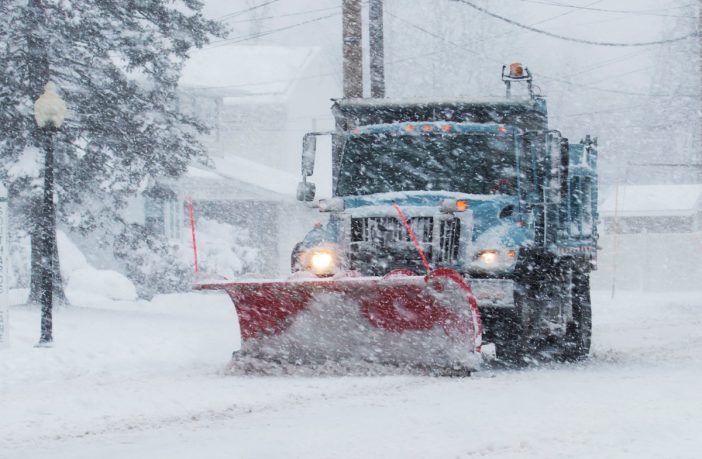Governor Cuomo has updated New Yorkers on storm recovery efforts as two additional storms could hit the state on Friday and Sunday. According to the National Weather Service, the Hudson Valley appears to have received the most snowfall with 25 inches of snow being reported in some areas. Elsewhere snowfall rates ranged from 12 to 18 inches in New York City and on Long Island, with less than 12 inches in areas further upstate. As response work continues, New York is now tracking two other potential storms which may impact New York on Friday and Sunday. While forecasts are still being refined, the Friday storm is expected to produce winter weather throughout downstate New York, as well as parts of upstate. The Sunday storm could be another, larger snow storm which may impact a larger portion of the state. The Governor is continuing to urge New Yorkers to use caution if traveling and be sure to leave room for snowplows as snow continues to fall throughout much of the state.
“As this winter storm continues to move North and impact parts of the state with snow and high winds, our emergency response crews are working around the clock to clear roadways and make conditions safer for travelers,” Governor Cuomo said. “Our teams have done a great job responding to this storm, and we are already beginning to prepare for yet another round of winter weather that is expected for this weekend. To all New Yorkers – continue to avoid nonessential travel throughout the duration of these weather systems so our crews can do their jobs safely and effectively.”
The storm is expected to move out of the northeast throughout the remainder of the day. In the next 12 hours, the North Country could see 10 to 12 inches of snow. Central New York and the Finger Lakes could see 6 to 8 inches, and the Capital Region could see 1 to 2 inches. Temperatures will range between mid 20s to low 30s across much of the state with winds 10 to 15 mph with gusts up to 30 mph in several locations.
Drifting and blowing snow will remain a concern due to gusty winds and light snow, which could produce slippery surfaces and reduced visibilities. Travel could be adversely affected in some locations through this evening, so drivers should take caution and slow down on the roadways.
For a complete listing of weather watches and warnings in your area, visit your area’s National Weather Service website.
Agency Preparations
Division of Homeland Security and Emergency Services
The New York State Division of Homeland Security and Emergency Services’ Emergency Operations Center remains activated due to the COVID-19 pandemic and will closely monitor weather conditions, coordinate state response operations and remain in contact with localities throughout the duration of the event. State stockpiles are prepared to deploy assets to localities to support any storm-related needs, including pumps, chainsaws, sandbags, generators, cots, blankets and bottled water.
Department of Transportation
The State Department of Transportation is responding with 3,645 supervisors and operators available statewide. In addition, to support snow and ice activities in critical areas, a total of 162 staff including: 150 plow truck operators, 4 plow crew supervisors, 2 Equipment Operator Instructors, 4 mechanics, 1 mechanic supervisor and 1 safety officer; 24 plow trucks, 6 snow blowers and 2 mechanic service trucks have been deployed to the Mid-Hudson region and Long Island from other regions.
Regional crews are currently engaged in snow and ice storm response efforts. All residency locations will remain staffed for 24/7 operation throughout the duration of the event and priority cleanup operations. All available snow and ice equipment is deployed.
Fleet mechanics in affected areas will be staffing all main residency locations 24/7 to perform repairs and keep trucks on the road. Statewide equipment numbers are as follows:
- 1,625 large plow trucks
- 175 medium duty plows
- 52 tow plows
- 316 large loaders
- 38 snow blowers
Thruway Authority
The Thruway Authority has 694 operators and supervisors ready to respond with 252 large snow plows, 100 medium snow plows, 11 tow plows and 63 loaders across the state with more than 119,000 tons of road salt on hand. The Thruway Authority deployed an additional 10 snow plows, 1 large snow blower and 20 operators from its Buffalo and Syracuse Divisions to the New York Division where the storm is expected to have a greater impact.
Variable Message Signs and social media are utilized to alert motorists of winter weather conditions on the Thruway.
The Thruway Authority encourages motorists to download its mobile app which is available for free on iPhone and Android devices. The app provides motorists direct access to real-time traffic and navigation assistance while on the go. Motorists can also sign up for TRANSalert e-mails which provide the latest traffic conditions along the Thruway here.
Department of Environmental Conservation
DEC Environmental Conservation Police Officers, Forest Rangers, Emergency Management staff, and regional staff are on alert and monitoring the developing situation and actively patrolling areas and infrastructure likely to be impacted by severe weather. Available assets, such as snowmobiles and ATVs, are strategically positioned throughout the most heavily impacted area to assist with any emergency response.
Metropolitan Transportation Authority
The MTA’s snow clearing and salting efforts continue today as normal service resumes on the New York City subway with residual delays. Buses are still operating at 75% of regular weekday service, with articulated buses replaced with standard buses. All vehicles are outfitted with tire chains. The Long Island Rail Road is running weekend service, with regular schedules in effect at Metro-North Railroad. The empty and tandem tractor trailer ban for MTA Bridges and Tunnels has also been lifted. The Authority will continue to monitor conditions throughout the day. Approximately 9,500 New York City Transit workers, 2,000 Long Island Rail Road workers and 1,600 Metro-North workers have been mobilized since yesterday to ensure that tracks remain clear, the third rail is de-iced, and stations, platforms and stairways are safe for customer use. New Yorkers are urged to stay home and avoid unnecessary travel if possible. Those who must travel can check for service updates on the MTA website and app, as well as the agency’s various social media channels.
Office of Parks, Recreation and Historic Preservation
New York State Park Police and park personnel are on alert and closely monitoring weather conditions and impacts. State Park Police snowmobile units and park Sawyer crews are prepared to assist in the storm response. Park visitors should check parks.ny.gov or call their local park office for the latest updates regarding park hours, openings and closings.
Department of Public Service
New York’s utilities have approximately 6,000 workers available to engage in damage assessment, response and restoration efforts across New York State. Department of Public Service staff will track the utilities’ work throughout the storm event and will ensure the utilities shift the appropriate staffing to the regions anticipated to experience the greatest impact.
New York Power Authority / Canal Corporation
The New York Power Authority and the Canal Corporation staff has performed preparations for the forecasted weather to ensure all facilities, assets and equipment are secured and ready. The Power Authority is prepared to support power restoration activities if needed.
New York State Police
State Police are prepared to deploy additional Troopers as needed to affected areas. All State Police specialized vehicles, including four-wheel drive vehicles, snowmobiles and Utility Task Vehicles, are staged and ready for immediate response. All Troop emergency power and communications equipment has been tested.
Port Authority
With the anticipated high accumulation of snow, combined with high winds and coastal flooding, the Port Authority urges everyone to avoid unnecessary travel across the region to keep roadways clear for emergency vehicles and snow removal. The South Walk on the George Washington Bridge, the shared use path at the Bayonne Bridge, and the shared use path at the Goethals Bridge are closed and will remain closed for the duration of the storm. PATH resumed underground service between Journal Square-33rd Street via Hoboken and Journal Square-World Trade Center at 11 a.m. Due to treacherous snow and wind conditions that continue to impede snow removal efforts, PATH service at Newark Penn Station and Harrison Station will remain suspended until further notice. Travelers through the Port Authority’s airports should check directly with their airline for the latest information on delays, cancelations, and rebookings before leaving for the airport. Several bus carriers operating out of the Port Authority Bus Terminal have suspended operations today. Travelers should check with bus carriers for updates and rebookings before leaving for the terminal. As conditions change across the region, customers are encouraged to check for updates on Port Authority facilities’ social media, sign up for PA alerts, or download one of the PA mobile apps for the latest information about Port Authority facilities.
Safety Tips
Winter Safety
Some of the most important tips for safe driving include:
- When winter storms strike, do not drive unless necessary.
- Use caution on bridges as ice can form quicker than on roads.
- If you must travel, make sure your car is stocked with survival gear like blankets, a shovel, flashlight and extra batteries, extra warm clothing, set of tire chains, battery booster cables, quick energy foods and brightly colored cloth to use as a distress flag.
- If you have a cell phone or other communications device such as a two-way radio available for your use, keep the battery charged and keep it with you whenever traveling. If you should become stranded, you will be able to call for help, advising rescuers of your location.
The leading cause of death and injuries during winter storms is transportation accidents. Before getting behind the wheel, make sure that your vehicle is clear of ice and snow; good vision is key to good driving. Plan your stops and keep more distance between cars. Be extra alert and remember that snowdrifts can hide smaller children. Always match your speed to the road and weather conditions.
It is important for motorists on all roads to note that snowplows travel at speeds up to 35 mph, which in many cases is lower than the posted speed limit, to ensure that salt being dispersed stays in the driving lanes and does not scatter off the roadways. Oftentimes on interstate highways, snowplows will operate side by side, as this is the most efficient and safe way to clear several lanes at one time.
Motorists and pedestrians should also keep in mind that snowplow drivers have limited lines of sight, and the size and weight of snowplows can make it very difficult to maneuver and stop quickly. Snow blowing from behind the plow can severely reduce visibility or cause whiteout conditions. Motorists should not attempt to pass snowplows or follow too closely. The safest place for motorists to drive is well behind the snowplows where the roadway is clear and salted.
Flood Safety
- Know the county in which you live and the names of nearby cities. Severe weather warnings are issued on a county basis.
- Learn the safest route from your home or business to high, safe ground should you have to leave in a hurry.
- Develop and practice a ‘family escape’ plan and identify a meeting place if family members become separated.
- Make an itemized list of all valuables including furnishings, clothing and other personal property. Keep the list in a safe place.
- Stockpile emergency supplies of canned food, medicine and first aid supplies and drinking water. Store drinking water in clean, closed containers
- Plan what to do with your pets.
- Have a portable radio, flashlights, extra batteries and emergency cooking equipment available.
- Keep your automobile fueled. If electric power is cut off, gasoline stations may not be able to pump fuel for several days. Have a small disaster supply kit in the trunk of your car.
- Find out how many feet your property is above and below possible flood levels. When predicted flood levels are broadcast, you can determine if you may be flooded.
- Keep materials like sandbags, plywood, plastic sheeting and lumber handy for emergency waterproofing
Have disaster supplies on hand, including:
- Flashlight and extra batteries;
- Battery-operated radio and extra batteries;
- First aid kit and manual;
- Emergency food and water;
- Non-electric can opener;
- Essential medicines; and
- Checkbook, cash, credit cards, and ATM cards.
For more safety tips for all types of weather events, visit the DHSES website at www.dhses.ny.gov/oem/safety-info/index.cfm.













